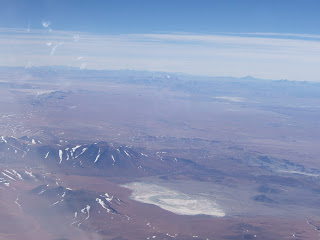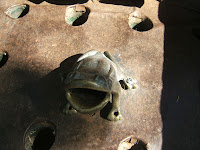I do two or three jigsaw puzzles a year: one in January when we go to the coast for a weekend with my parents and my brother and his family, and another one (maybe two) over winter break or during the summer. This break, I've been putting together a 1000-piece puzzle of the Mona Lisa.
I don't usually buy "great art" puzzles--I tend more toward landscapes or, honoring my children's interests, marine life--but my husband bought several at a bookstore liquidation last summer, and my son lured me in with the siren song of parent-child collaboration. Of course, my collaborator is long gone, and the card table has been commandeered for an epic game of Talisman, so my puzzle--on its floppily recycled corrugated board--has been relegated to the family room floor, where I hunker over it obsessively, inviting paralysis, or at least a bad back.
I enjoy the momentary triumphs (ha! the hairline is complete!), the undisciplined hum of just-one-more-piece-and-then-I'll-quit, the time to muse.
Spread across five or six small pieces, the famous smile is indeed enigmatic. It took a while even to identify the partial, blurry curves as lips. The puzzle also has a higher than average incidence of false positives--those pieces that definitely fit, until you realize they don't. Pieces that seem to fit for a long time, throwing the rest of the project off.
It's completely cheesy to commune with great art through a cardboard puzzle mass produced in China, sold for cheap by a failing bookstore, stored on a shelf cluttered with board games and kids' books and weird crafts sets no one will admit to having purchased or requested. But I do find myself thinking about that smile, and the blend of colors, and the expression in her eyes. And the aged, cracked paint, reproduced here as a network of tiny amber lines or smears that interweave and distort and return. Brand new and glossy in all its antique fragility--memory and stories and play-time, oh my!
What would Leonardo think? What would any of them think, the composers whose most famous concertos litter the universe of ringtones and commercial jingles, the painters sold and resold on umbrellas and coffee mugs? I imagine a dialogue or perhaps a debate (like the dreadful film we watched in AP history, with James Madison and Alexander Hamilton reanimated off marble slabs to declaim the Federalist Papers) between two much-marketed artists on the merits of this particular flavor of immortality. Is it always better to be remembered? Sitting in a café in Mendoza in November, the kids and I had worked out half a story along those lines, the composer back to life and hearing his music in the oddest places, distorted, digitized but, hey, still audible.
When I was in Rosario, one of my treats was the Sunday free showing at Cine el Cairo, a public theater that offered Argentine films to an enthusiastic, all ages crowd on Sunday afternoons. I wasn't able to go that often--weekend trips began to intervene--but one of the films I saw was Rompecabezas, a film about a woman who discovers she has a gift for jigsaw puzzles. It's what's often called a "quiet" film; I found it absorbing. None of my local acquaintances had heard of it, so I also had the pleasure of seeming to be in the know as I described it to them. The protagonist's choice at the end wasn't entirely clear, but I've kept thinking about her, and the way the patient organization of fragmented images--the puzzle-building process--was reflected in the structure of the film.
The movements of her hands, the way she surveyed the jumble of pieces as she began a puzzle and then arranged and understood them, also seems an apt representation of the way one might organize a story. In particular, I like the tactile sense of those pieces--weighed, removed, shifted, stacked. The way a story might be built, as if with lumber or stone. Or bits of cardboard.



































